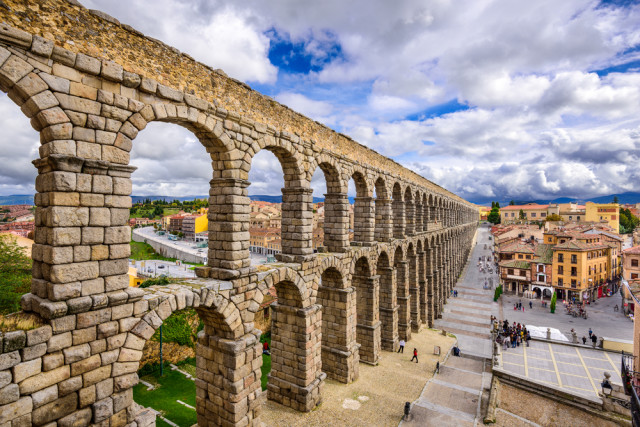The mighty Roman Empire started gradually invading and turning the Iberian Peninsula into Hispania in the first two centuries BC a pax romana that would last till the 4th century AD, when it started to lose ground to barbarian tribes such as the Gauls, Vandals, and Visigoths; by 585, Romanised Visigoths effectively controlled the entire peninsula for more than a century up until the Muslim invasions from North Africa.
But those nearly 700 years were decisive – indeed, fateful – for Iberia. During this period of colonisation, the vulgar Latin evolved into Spanish, Catalan, Galician, and various dialects; Christianity was introduced at the religion took hold in various parts of the empire, including Rome itself; and urbanised centres were established that became the great cities of Spain and Portugal. It’s the remnants of these Roman cities that I find among Spain’s most fascinating sites. And here are ancient Rome’s greatest local hits (far from an exhaustive list, by the way!):
A Coruña
There’s a lot of competition for most spectacular remnant of ancient Rome in Iberia, but the 1,900-year-old Torre de Hércules (Tower of Hercules, which used to be known as the less-catchy-sounding Farum Brigantium) still a working lighthouse soaring 57 metres (187 feet) just outside A Coruña, astonishes both as an imposing landmark and one in remarkably good condition (it’s continued to be maintained and renovated, after all). It’s open to the public, too. the only thing I find mildly disappointing is the flip side of that renovation, as thanks to a neoclassical makeover in 1788 it it doesn’t really look like anyone’s idea of “ancient Roman” these days. Never mind – mere quibbling.
Mérida
Founded in 25 AD, the capital of the western community of Extremadura, the onetime Emerita Augusta can boast more Roman remnants than any single Spanish city, including its amphitheatre, Circus Maximus, Aqueduct of Miracles, the Roman Theatre, doughty stone bridge, Trajan’s Arch, Temple of Diana (below), and Villa Miltreo – all very good reasons the city’s historic core has been designated a UNESCO World Heritage Site. It’s practically like a theme park called Hispania-land!
Segovia
Few cities deliver more “wow factor” than the historic centre of this small Castilian city northeast of Madrid – how many cities can you think of whose downtown is split down the middle by an enormous ancient Roman aqueduct? Dated back to the 81-96 AD reign of the emperor Domitian, this granite behemoth has 167 arches, and has been rebuilt and proudly maintained over the centuries as a symbol of Segovia. Certainly an unforgettable sight…
Tarragona
A couple of hours down the Catalonia coast from Barcelona, this settlement founded by ancient Iberians in the 5th century BC became as of the 3rd century BC became Romanised, and as Tarraco evolved into one of the foremost cities of the Roman Empire in Iberia thanks to its strategic position on the Mediterranean and its wide bay.
What that means for today is that we’ve been left with some of the most cool and complete Roman ruins outside Italy from Iberia‘s oldest Roman city. The foremost landmark of that era is the impressive semicircular amphitheatre, handsomely located by the sea (these days it’s partly a reconstruction, because over the centuries years, before the preservation mentality took hold, locals mined it as a source of building stones). Most of the other Roman remnants are nearby in the section of the city north of the handsome avenue Rambla Vella, such as the ancient city walls accessed via the Portal del Roser on Avinguda Catalunya (impressive gateways and great city/sea views from the battlements); the Praetorian Forum and Roman Circus complex, where chariot races were held and civic functions performed; and the main Roman forum, the Fòrum de la Colònia. (Others just outside the city proper include the Triumphal Arch of Berà, dating from the 3rd century BC, a 1st-century aqueduct today known as El Pont del Diable, “Devil’s Bridge”). Also highly recommended is a stop at the Museu Nacional Aquelògic de Tarragona, which not only does a bang-up job curating, exhibiting, and explaining the treasures of Roman Tarraco, but also includes original mosaics and sections of the ancient city walls.
Zaragoza
The the remnants of the ancient Roman city of Caesaraugusta (you can see how that word eventually evolved into Zaragoza, right?) have been uncovered relatively recently, and now include sites open to the public such as the 6,000-seat theatre, the Teatro Romano; the nearby Termas Públicas (public baths); the Museo del Puerto Fluvial (remants/relics of the old Roman river docks and port area); and right alongside the basilica and La Seo, the Museo del Foro de Caesaraugusta, where you can get an eyeful of some shops, porticoes, artifacts, and even a chunk of the ancient sewer system.
Get best fares to Spain from the U.K., from the USA.
More sites/info: SpainIsCulture.com.
images | Sean Pavone, Cortyn



